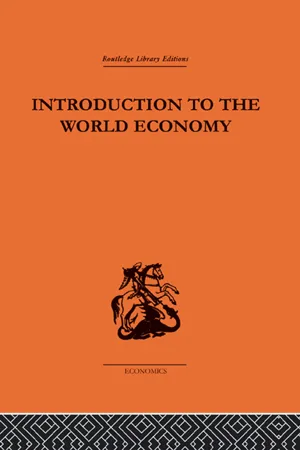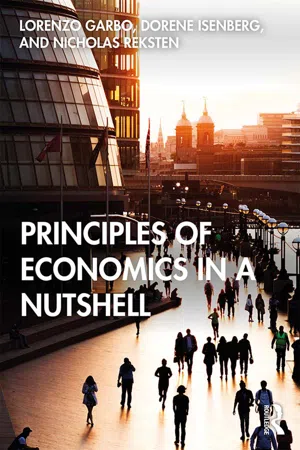Economics
Supply of Loanable Funds
The supply of loanable funds refers to the total amount of funds available for lending in a financial market. It is influenced by factors such as savings, investment, and government policies. An increase in the supply of loanable funds typically leads to lower interest rates, while a decrease in supply results in higher interest rates.
Written by Perlego with AI-assistance
Related key terms
Related key terms
1 of 4
Related key terms
1 of 3
3 Key excerpts on "Supply of Loanable Funds"
- eBook - ePub
- W. Charles Sawyer, Richard L. Sprinkle(Authors)
- 2020(Publication Date)
- Routledge(Publisher)
5Along with this demand for loanable funds, there is an associated Supply of Loanable Funds. This supply represents the total amount of money available to be borrowed. The Supply of Loanable Funds, S, is illustrated in Figure 17.1 as perfectly inelastic (vertical). That is, the amount of loanable funds available in the domestic economy is not related to the interest rate. In the short run, the amount of money held as savings by the public determines this Supply of Loanable Funds.6 Let us assume, initially, that when the government budget is balanced, the demand for loanable funds is represented by D. Given this demand and supply for loanable funds, the equilibrium in the loanable funds market is at E at an equilibrium interest rate of ie .As the government adopts an expansionary fiscal policy, the government’s added demand for loanable funds will cause the demand for loanable funds to increase from D to D¢. With only domestic loanable funds available, the equilibrium would change from E to F and the interest rate rises from ie to i¢. In a closed economy, an expansionary fiscal policy causes interest rates to rise. However, in an open economy with freely flowing international financial capital, the rise in domestic interest rates causes an inflow of foreign capital as foreign investors see a higher rate of return. This effect occurred in the U.S. economy during the 1980s. U.S. interest rates rose as a result of an expansionary fiscal policy. As foreign capital moves into the domestic market, it augments the domestic Supply of Loanable Funds. This additional Supply of Loanable Funds from foreigners is illustrated in Figure 17.1 as a rightward shift of the Supply of Loanable Funds from S to S¢. As a result, the equilibrium in the loanable funds market changes from F to G, and the inflow of foreign capital lowers domestic interest rates from i¢ back toward ie .7 The net result of an expansionary fiscal policy in an open economy with freely flowing capital is that less upward pressure is put on domestic interest rates than would be the case in a closed economy. Figure 17.1 indicates that a larger federal government budget deficit tends to increase domestic interest rates, and the higher domestic interest rates cause an inflow of foreign capital into the country. As we described in Chapter 16 , the capital flows have an effect on the equilibrium exchange rate. This effect on the exchange rate is illustrated in Figure 17.2 - eBook - ePub
- A J Brown(Author)
- 2013(Publication Date)
- Routledge(Publisher)
There is some evidence that, both in the United Kingdom and in the United States, the amount of money that is used regularly for transactions connected with the production and distribution of goods and services amounts to about two months’ income for the whole economy. The total amount of money existing in these, and most other highly developed economies is, however, very much greater than that. For the United States, United Kingdom, France, Italy, and Australia, for instance, it was in 1953 about four months’ income, though markedly less in Japan, Germany, and Sweden. The excess of the total supply of money over the amount regularly needed for transactions consists, of course, of the sums which people find it convenient to hold to meet an emergency, or of those parts of their saved-up wealth which they have not seen fit to invest in securities or other income-yielding property, perhaps because the cost and trouble of investing is too great, or perhaps because they are afraid of such securities or property being low in price at the (probably indefinite) future time when they might want to sell them. The point to note is that these quantities of money in most highly-developed modern economies are large—the total supply of money for all purposes is usually very generous in relation to the requirements of industry and trade alone. That, however, does not mean that plenty of money is always available for people who would like to expand their payments in connection with production, investment, or consumption. The money market does not manage to make by any means all the money which is lying idle available for spenders even at a price, and the price (in interest) which would be necessary to get some of it is also no doubt high. Although the banks and other monetary authorities, which are able to create money, generally adjust their supply to a large extent in conformity with the demands which are made on them for genuine purposes of industry or trade, they have it in their power—and sometimes exercise the power—to put a curb on spending, and thus on the volume of production, even when the total supply of the money in the economy might look, in the light of the foregoing discussion, ample to finance the regular payments required by production and distribution.We can now sum up. In an exchange economy, where every good and service produced is exchanged for money, the basic part of the machinery by which the system works is a circular flow of money, from productive enterprises to the households of the people who provide the factors of production, and back again. This flow is somewhat complicated by saving, by the financial activities of the government, and by foreign trade. When the flows of money and of commodities in the economy are steady, the purchase of goods for investment of any kind is financed by the savings which flow into the money market from households, enterprises, or the public authorities. The condition of the maintenance of a steady flow is that any excess of saving over investment within the country should be balanced by an excess of exports over imports. If such a balance does not exist, the flow of money will either expand or contract, with parallel effects on the volume of production and/or the level of prices, so that economic activity and the price level are bound up with the flow of money. - eBook - ePub
- Lorenzo Garbo, Dorene Isenberg, Nicholas Reksten(Authors)
- 2020(Publication Date)
- Routledge(Publisher)
I* remains constant). The interest rate increases because there is an excess demand of loanable funds caused by the firms’ increased willingness to invest, while the supply of funds remains constant.FIGURE 6.3 Loanable Funds Model: nudging firms to invest moreOpportunity for further reflectionIn a more realistic scenario, in which Private Savings depend positively on the interest rate, would the overall effect of such nudging policy be different?3. Nudging households to save a different percentage of their disposable income.Suppose that some government agency is successful in convincing households to save a higher percentage of their disposable income. Private Savings would increase, and thus National Savings would increase, shown in Figure 6.4 .FIGURE 6.4 Loanable Funds Model: nudging households to save moreAn increase in the supply of funds pushes the interest rate down. A lower interest rate increases the level of investments firms are willing to undertake. Given that the overall effect of this policy is an increase in investments, this is a very desirable outcome for a Classical macroeconomist.Opportunity for further reflectionOh wait! But if households save more out of their disposable income, who’s going to buy the consumption goods firms will produce with the additional investments? What happens to Say’s Law?Let’s recap the Classical framework. The Classical, supply-side model conceives the economy as always at full employment: every movement away from the full employment level of output (and therefore income) is quickly corrected by movements in prices, so that resources are always fully employed, and the supply of every good and service finds its own demand (Say’s Law). The business cycle – the ups and downs of the economy – in the Classical framework is seen as completely transitory and self-correcting: the business of macroeconomists is to interfere the least with the natural movement of the economy along the trend. Macroeconomic equilibrium in this model is guaranteed by the interest rate, that adjusts so that the supply of funds in the economy (National Savings) is equal to the demand of funds (investments). This is why this model is also known as the Loanable Funds Model
Index pages curate the most relevant extracts from our library of academic textbooks. They’ve been created using an in-house natural language model (NLM), each adding context and meaning to key research topics.
Explore more topic indexes
Explore more topic indexes
1 of 6
Explore more topic indexes
1 of 4


